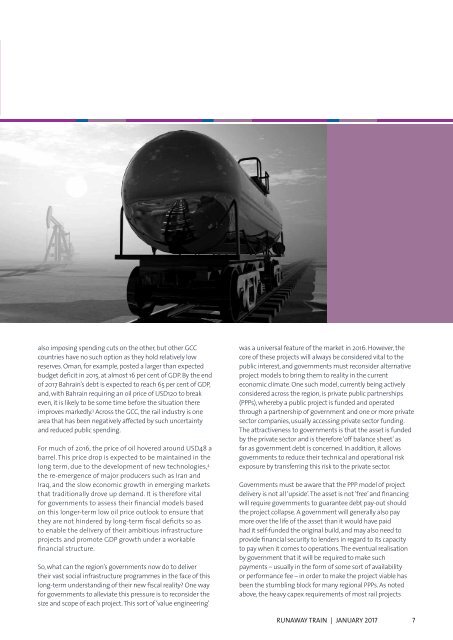Runaway Train
2jdqSdB
2jdqSdB
Create successful ePaper yourself
Turn your PDF publications into a flip-book with our unique Google optimized e-Paper software.
also imposing spending cuts on the other, but other GCC<br />
countries have no such option as they hold relatively low<br />
reserves. Oman, for example, posted a larger than expected<br />
budget deficit in 2015, at almost 16 per cent of GDP. By the end<br />
of 2017 Bahrain’s debt is expected to reach 65 per cent of GDP,<br />
and, with Bahrain requiring an oil price of USD120 to break<br />
even, it is likely to be some time before the situation there<br />
improves markedly. 3 Across the GCC, the rail industry is one<br />
area that has been negatively affected by such uncertainty<br />
and reduced public spending.<br />
For much of 2016, the price of oil hovered around USD48 a<br />
barrel. This price drop is expected to be maintained in the<br />
long term, due to the development of new technologies, 4<br />
the re-emergence of major producers such as Iran and<br />
Iraq, and the slow economic growth in emerging markets<br />
that traditionally drove up demand. It is therefore vital<br />
for governments to assess their financial models based<br />
on this longer-term low oil price outlook to ensure that<br />
they are not hindered by long-term fiscal deficits so as<br />
to enable the delivery of their ambitious infrastructure<br />
projects and promote GDP growth under a workable<br />
financial structure.<br />
So, what can the region’s governments now do to deliver<br />
their vast social infrastructure programmes in the face of this<br />
long-term understanding of their new fiscal reality? One way<br />
for governments to alleviate this pressure is to reconsider the<br />
size and scope of each project. This sort of ‘value engineering’<br />
was a universal feature of the market in 2016. However, the<br />
core of these projects will always be considered vital to the<br />
public interest, and governments must reconsider alternative<br />
project models to bring them to reality in the current<br />
economic climate. One such model, currently being actively<br />
considered across the region, is private public partnerships<br />
(PPPs), whereby a public project is funded and operated<br />
through a partnership of government and one or more private<br />
sector companies, usually accessing private sector funding.<br />
The attractiveness to governments is that the asset is funded<br />
by the private sector and is therefore ‘off balance sheet’ as<br />
far as government debt is concerned. In addition, it allows<br />
governments to reduce their technical and operational risk<br />
exposure by transferring this risk to the private sector.<br />
Governments must be aware that the PPP model of project<br />
delivery is not all ‘upside’. The asset is not ‘free’ and financing<br />
will require governments to guarantee debt pay-out should<br />
the project collapse. A government will generally also pay<br />
more over the life of the asset than it would have paid<br />
had it self-funded the original build, and may also need to<br />
provide financial security to lenders in regard to its capacity<br />
to pay when it comes to operations. The eventual realisation<br />
by government that it will be required to make such<br />
payments – usually in the form of some sort of availability<br />
or performance fee – in order to make the project viable has<br />
been the stumbling block for many regional PPPs. As noted<br />
above, the heavy capex requirements of most rail projects<br />
<strong>Runaway</strong> train | January 2017<br />
7


